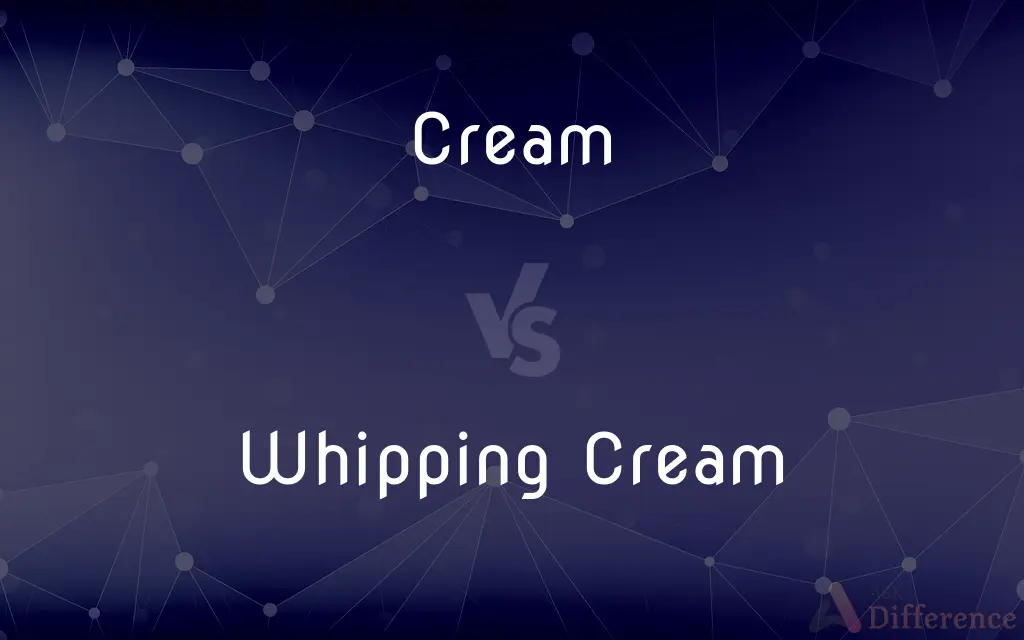Cream vs. Whipping Cream — What's the Difference?
Edited by Tayyaba Rehman — By Fiza Rafique — Published on March 6, 2024
Cream is a dairy product with a wide range of fat contents, used in both cooking and baking, while whipping cream, specifically designed for whipping, has a higher fat content to achieve soft peaks when beaten.

Difference Between Cream and Whipping Cream
Table of Contents
ADVERTISEMENT
Key Differences
Cream is a versatile dairy product derived from milk, varying widely in fat content from light to heavy creams, each suited for different culinary uses. Whipping cream, on the other hand, falls within this spectrum but is specifically processed to have a fat content (typically around 30-36%) that makes it ideal for whipping, enabling it to hold its shape and form soft peaks for desserts and toppings.
The fat content in cream determines its culinary applications, with lower-fat creams used for enriching coffees and soups, and higher-fat versions like heavy cream used for making sauces and baked goods. Whipping cream's higher fat content allows it to be whipped into a stable, airy structure, perfect for garnishing desserts.
In terms of availability and use, regular cream, depending on its fat content, can be found in various forms, including half-and-half, light cream, and heavy cream, catering to a broad range of cooking needs. Whipping cream is specifically marketed for its ability to be whipped, though it can also be used in recipes where its fat content is beneficial, such as in ganaches or as a decadent addition to hot beverages.
Nutritionally, all creams are high in fat, but whipping cream is particularly rich, making it a more calorie-dense option. This difference in fat content not only affects its nutritional profile but also its culinary behavior and texture in recipes.
Despite these differences, both cream and whipping cream share the common characteristic of enhancing the richness and flavor of dishes. Whether being used to add creaminess to coffee or to top a pie with a fluffy, whipped garnish, each has its unique place in the kitchen.
ADVERTISEMENT
Comparison Chart
Fat Content
Varies widely (18-36%)
Typically 30-36%
Culinary Uses
Broad, including cooking and baking
Primarily for whipping; also in cooking
Whipping Ability
Depends on fat content
Specifically designed to whip well
Nutritional Profile
High in fat, varies with fat content
Higher in fat, more calorie-dense
Availability
Wide variety, from half-and-half to heavy cream
Marketed for its whipping quality
Compare with Definitions
Cream
Cream is the high-fat layer skimmed from milk, used in various dishes.
She stirred some cream into her coffee to enrich its flavor.
Whipping Cream
Unlike regular cream, it's specifically processed for whipping.
Whipping cream is sold with the promise of perfect peaks every time.
Cream
It varies in fat content, suitable for different culinary applications.
The recipe called for light cream to add a subtle richness.
Whipping Cream
Whipping cream has a high fat content, enabling it to hold whipped peaks.
She whipped the cream until it formed soft peaks for the dessert topping.
Cream
Some creams are thickened or fermented to create products like sour cream.
Sour cream was dolloped on top of the soup for extra tang.
Whipping Cream
Though primarily for whipping, it can be used in recipes requiring high fat.
Whipping cream added a velvety texture to the homemade ice cream.
Cream
Heavy cream is used for making sauces and baked goods.
He used heavy cream to create a creamy Alfredo sauce.
Whipping Cream
It's ideal for garnishes, fillings, and frostings because of its stability when whipped.
The cake was frosted with a light and airy whipping cream frosting.
Cream
Cream adds richness and depth to both sweet and savory dishes.
A splash of cream transformed the chocolate dessert into a luxurious treat.
Whipping Cream
Can be sweetened and flavored for more decadent desserts.
Vanilla-scented whipping cream was the perfect finish to the pie.
Cream
The yellowish fatty component of unhomogenized milk that tends to accumulate at the surface.
Cream
The butterfat/milkfat part of milk which rises to the top; this part when separated from the remainder.
Take 100 ml of cream and 50 grams of sugar…
Cream
(informal) Frosting, custard, creamer, or another substance similar to the oily part of milk or to whipped cream.
Cream
To rub, stir, or beat (butter) into a light creamy consistency.
Cream
The rich, oily, and yellowish part of milk, which, when the milk stands unagitated, rises, and collects on the surface. It is the part of milk from which butter is obtained.
Cream
The part of milk containing the butterfat
Common Curiosities
Can I use regular cream instead of whipping cream for desserts?
It depends on the fat content; heavy cream can often be used, but lighter creams won't whip as well.
Why does whipping cream whip better than regular cream?
Its higher fat content stabilizes the air bubbles formed during whipping, creating a fluffy texture.
Can whipping cream be used in coffee?
Yes, but it's richer and thicker than regular cream, altering the coffee's texture and flavor.
What's the best way to store cream and whipping cream?
Both should be stored in the refrigerator and used by the expiration date for best quality.
What is the main difference between cream and whipping cream?
The main difference is the fat content, with whipping cream having enough fat to be whipped into peaks.
Is whipping cream the same as heavy cream?
Whipping cream and heavy cream are similar in fat content, but whipping cream is slightly lighter, making it ideal for whipping.
Are there low-fat versions of whipping cream?
Light whipping cream is available but has a lower fat content and may not hold peaks as well.
How do I choose between cream and whipping cream for a recipe?
Consider the desired texture and fat content; use whipping cream for light, airy textures and regular cream for richness.
Is there a non-dairy alternative to whipping cream?
Yes, there are plant-based alternatives made from coconut milk, soy, or almond milk that can whip similarly.
Can whipping cream be over-whipped?
Yes, over-whipping can turn it into butter, separating the fat from the liquid.
How does the fat content affect the taste of cream?
Higher fat content generally means a creamier, richer flavor.
What are some common uses for whipping cream?
Whipping cream is commonly used for toppings, fillings, and to add richness to desserts and beverages.
How can I substitute for whipping cream in a recipe?
For whipping purposes, chilled full-fat coconut milk can work, but it won't mimic the exact flavor or texture.
Can I freeze whipping cream?
Yes, though it may affect the texture slightly; it's best used in cooked dishes after freezing.
Is whipping cream healthier than regular cream?
Not necessarily; its higher fat content makes it more calorie-dense.
Share Your Discovery

Previous Comparison
Part Time Job vs. Casual Job
Next Comparison
Walking Stick vs. Walking CaneAuthor Spotlight
Written by
Fiza RafiqueFiza Rafique is a skilled content writer at AskDifference.com, where she meticulously refines and enhances written pieces. Drawing from her vast editorial expertise, Fiza ensures clarity, accuracy, and precision in every article. Passionate about language, she continually seeks to elevate the quality of content for readers worldwide.
Edited by
Tayyaba RehmanTayyaba Rehman is a distinguished writer, currently serving as a primary contributor to askdifference.com. As a researcher in semantics and etymology, Tayyaba's passion for the complexity of languages and their distinctions has found a perfect home on the platform. Tayyaba delves into the intricacies of language, distinguishing between commonly confused words and phrases, thereby providing clarity for readers worldwide.
















































